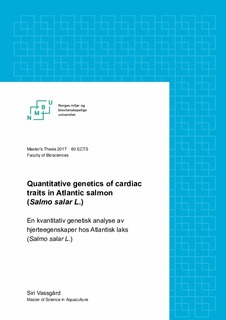| dc.contributor.advisor | Olesen, Ingrid | |
| dc.contributor.advisor | Gjerde, Bjarne | |
| dc.contributor.advisor | Hjelmeland, Roy | |
| dc.contributor.author | Vassgård, Siri | |
| dc.coverage.spatial | Norway | nb_NO |
| dc.date.accessioned | 2017-09-07T08:22:40Z | |
| dc.date.available | 2017-09-07T08:22:40Z | |
| dc.date.issued | 2017 | |
| dc.identifier.uri | http://hdl.handle.net/11250/2453492 | |
| dc.description.abstract | Mortality of apparently healthy looking fish is frequently reported close to harvesting size of Atlantic salmon (Salmo salar L.), causing concerns from an economic and ethical perspective for the Aquaculture industry. Autopsy and further analyses often reveal smaller, abnormal hearts and signs of cardiac disorders. The aim of this thesis was therefore to investigate the magnitude of genetic variation in ventricle weight and heart index (ventricle weight/body weight), and the impact of the traits on body weight, survival and cardiomyopathy syndrome (CMS).
The study was based on a total of 4667 fish, the offspring of 173 sires and 341 dams (341 fullsib families) of the Mowi strain. In the sea water period the fish were naturally challenged with CMS and fish that died were classified as death due to CMS or unknown causes. At harvest size body weight and ventricle weight were recorded, and a subjective visual score was given to indicate the presence (score 1, 2, 3) or not (score 0) of CMS in different organs. A tissue sample from the ventricle tip of a small sample of 47 of the dead fish was taken for qPCR analysis for CMS.
The study showed that ventricle weight (h2=0.34) and heart index (h2=0.20) were heritable traits. Ventricle weight had a very high, positive genetic correlation with body weight (0.92). However, as this correlation was less than one, direct selection for increased harvest weight may over time result in a relatively smaller ventricle or heart index as also indicated by the negative correlation between body weight and heart index (-0.23).
Survival of CMS had higher heritability (h2=0.25) than both overall survival (h2=0.17) and the visual score for CMS recorded at harvest (h2=0.09). Genetic correlations between overall survival on one hand, and smolt weight, harvest body weight, ventricle weight and heart index on the other, were in general low, but positive and thus favorable. The magnitude of the genetic correlation of CMS score at harvest with harvest weight (0.33), ventricle weight (0.51) and heart index (0.48) indicates an unfavorable genetic association between these traits and CMS. Consequently, direct selection also for increased resistance against CMS is needed to reduce economic losses and improve welfare in the sea phase for Atlantic salmon.
Worth a notice is that the estimated genetic correlations may be biased as the body weight and ventricle weight were missing for those fish that died prior to harvest, although including also smolt weight in the multitrait sire and dam model should to some extent account for this. | nb_NO |
| dc.description.abstract | Det rapporteres hyppig om dødelighet av tilsynelatende friske fisk nær slaktestørrelse av Atlantisk laks (Salmo salar L.), noe som fører til bekymring fra både et økonomisk og et etisk perspektiv i akvakulturindustrien. Obduksjon og videre analyser avslører ofte mindre, unormale hjerter og tegn på hjertesykdommer. Målet med denne oppgaven var derfor å undersøke omfanget av genetisk variasjon i ventrikkelvekt og hjerteindeks (ventrikkelvekt/kroppsvekt), og egenskapenes innvirkning på kroppsvekt, overlevelse og kardiomyopatisyndrom (CMS). Studien var basert på totalt 4667 fisk, avkommene til 173 fedre og 341 mødre (341 fullsøskenfamilier) av Mowi-stammen. I sjøfaseperioden fikk populasjonen et naturlig utbrudd av CMS, og fisker som døde ble klassifisert som død på grunn av CMS eller på grunn av ukjente årsaker. Ved slakt ble kroppsvekt og ventrikkelvekt registrert, og en subjektiv visuell scoring for å indikere om fisken hadde CMS (score 1, 2, 3) eller ikke (score 0) ble utført. En vevsprøve av ventrikkelspissen på 47 av de døde fiskene ble sendt til qPCR for analyse for CMS. Studien viste at ventrikkelvekt (h2=0.34) og hjerteindeks (h2=0.20) var arvelige egenskaper. Ventrikkelvekt hadde en veldig høy, positiv korrelasjon med kroppsvekt (0.92), men på grunn av at denne korrelasjonen var mindre enn 1, kan direkte seleksjon for økt kroppsvekt ved slakt føre til mindre ventrikkel eller hjerteindeks over tid, noe som også ble indikert av den negative korrelasjonen mellom kroppsvekt og hjerteindeks (-0.23). | nb_NO |
| dc.language.iso | eng | nb_NO |
| dc.publisher | Norwegian University of Life Sciences, Ås | nb_NO |
| dc.rights | Attribution-NonCommercial-NoDerivatives 4.0 Internasjonal | * |
| dc.rights.uri | http://creativecommons.org/licenses/by-nc-nd/4.0/deed.no | * |
| dc.subject | Atlantic salmon | nb_NO |
| dc.subject | Heart morphology | nb_NO |
| dc.subject | (Salmo salar L.) | nb_NO |
| dc.subject | CMS | nb_NO |
| dc.subject | Cardiomyopathy syndrome | nb_NO |
| dc.subject | Genetic variation | nb_NO |
| dc.subject | Heart index | nb_NO |
| dc.subject | Heart weight | nb_NO |
| dc.subject | Cardiac traits | nb_NO |
| dc.title | Quantitative genetics of cardiac traits in Atlantic salmon (Salmo salar L.) | nb_NO |
| dc.title.alternative | En kvantitativ genetisk analyse av hjerteegenskaper hos Atlantisk laks (Salmo salar L.) | nb_NO |
| dc.type | Master thesis | nb_NO |
| dc.description.version | submittedVersion | nb_NO |
| dc.subject.nsi | VDP::Landbruks- og Fiskerifag: 900 | nb_NO |
| dc.source.pagenumber | 56 | nb_NO |
| dc.description.localcode | M-AA | nb_NO |

